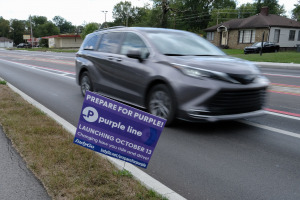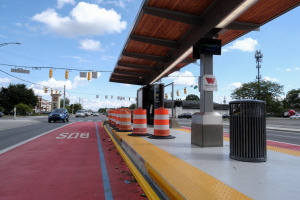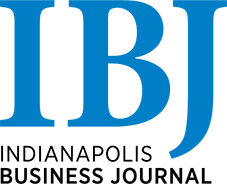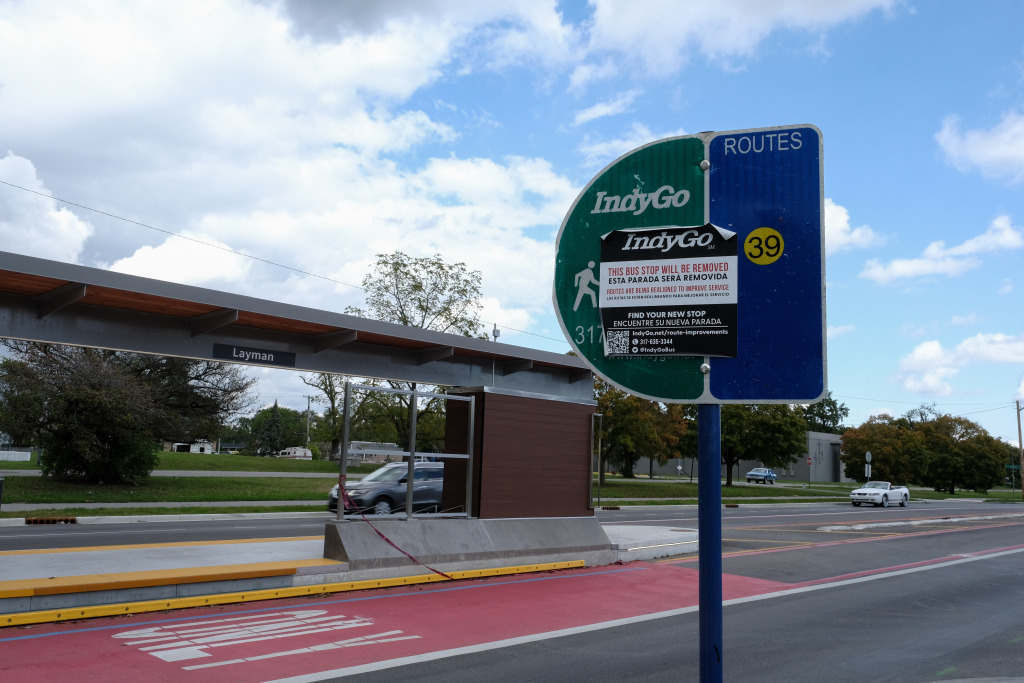Subscriber Benefit
As a subscriber you can listen to articles at work, in the car, or while you work out. Subscribe NowThe rapid-transit bus line connecting downtown Indianapolis to Lawrence and areas of the far-east side will take off from the Julia M. Carson Transit Center and run on freshly-painted lanes and new stations on Sunday, Oct. 13.
The $188 million Purple Line project broke ground in February 2022 with the goal of providing some of the city’s most distressed neighborhoods along the East 38th Street corridor and northward with better access to jobs, groceries and safe travel.
IndyGo says the new line will put 134,603 jobs and 58,470 people within walking distance of a bus station, along with serving a 61.6% minority population a 30.3% low-income population.

More than half of the budget for the Purple Line went toward infrastructure improvements, including the addition of sidewalks, multi-use paths, curb ramps, new traffic signals and stormwater systems.
IndyGo communications specialist Ashlynn Neumeyer said the line is bringing benefits to a historically underserved area.
“Without this project, who knows how long this community would have gone without improvements such as these,” Neumeyer said.
The Purple Line will replace most of Route 39, IndyGo’s most popular route aside from the Red Line. The route had a ridership of 58,046 in August, according to a September board report.
Ridership is occasionally a weak spot for IndyGo, which hit a low of 281,060 monthly riders in April 2020 and has yet to rebound fully to pre-pandemic levels. In August, total ridership reached 642,000, according to SAVI, compared with a 2018 average of 735,000 monthly riders.
IndyGo Chief Public Affairs Officer Carrie Black said there is no set goal for Purple Line ridership, but the agency would like to see growth above the Route 39 riders who will likely make the switch.
Riders will see some changes in the route in terms of frequency and means of payment, Black said. While IndyGo’s normal fixed routes have fare boxes aboard buses, riders pay for rapid-transit line rides prior to boarding at ticket vending machines on the platform or by using IndyGo’s MyKey app. After receiving a ticket, riders must validate their ticket at the validator.
“We strongly encourage that they switch over to MyKey,” Black said.
Instead of fixed schedules, rapid-transit lines have buses arriving at regular intervals. From downtown to the 38th and Park Avenue Station—where the Purple Line shares stations and lanes with the Red Line—buses will arrive roughly every five to 10 minutes. Further east along the route, buses will arrive roughly every 15 to 20 minutes.
Those riders will also notice improved platforms with covered seating and screens that show real-time updates on bus arrival.
The Purple Line is the second of IndyGo’s three planned rapid-transit lines. The first, the Red Line, launched in 2019. That launch had several hiccups that stemmed from implementing several new technologies at once, Black said, providing IndyGo with a learning opportunity.
Additionally, the agency saw increased wear-and-tear at the station from the heavier weight of the electric buses at stations, which meant concrete pads along the Red Line route needed to be rebuilt ahead of schedule.

“That was a very evident, very public lesson learned with our Red Line enhancements, we realized that we didn’t go deep enough when pouring the concrete slabs at each of the the stations,” Black said. Because of that, the concrete pads at the Purple Line are poured deeper.
The project was funded mostly out of federal coffers. The U.S. Department of Transportation’s Federal Transit Administration Small Starts Capital Investment Grant gave nearly $81 million to IndyGo for the project, while the FTA’s Capital Investment Grant contributed 50% of the $188 million total cost. The remaining costs were paid by local funding from the transit income tax, Indianapolis Department of Public Works and the Federal Highway Administration.
IndyGo will hold a ribbon-cutting ceremony for the new line on Friday, Oct. 18.
Please enable JavaScript to view this content.


As somebody who reads through IndyGo’s monthly board reports, they have been slowly but surely fixing Red Line problems and they’ve definitely been applying the lessons learned to the Purple Line. Leadership from 2020 & on has been good.
That’s great! Everyone complained about the Red Line when it was built, COVID happened, and look at it now. There’s more and more people riding it. In the long run these buses pay off. There’s private investment around the routes, houses getting remodeling, and neighborhoods coming up.
I ride the red line no less than three times per week, and am certainly not a critic of it. But implying that such investment and remodel work is a directly influenced by the Red Line is a bit much.
The Indianapolis MPO and IndyChamber have attributed roughly $700 million in economic development to the Red Line. Heck, there’s even a brand-new office building in Broad Ripple called, “Redline Offices.”
I don’t think it gets more obvious than that.
If you’re one to take dubious claims at face value, sure.
Do you have any resources that suggests the MPO and the Indy Chamber’s methodology is unsound? Or perhaps your own economic development analysis methodology?
Or are you just being a contrarian with nothing to actually back up your claims?
Wishful thinking. Unpaid ridership by a demographic that pushes any paying riders away is the norm now.
Still 95% empty busses ruining traffic.
Spin it any way you want, but a financial disaster for everyone but the bloated IndyGo staff, Chinese Bus manufacturer and union drivers.
The quicker we dismantle the system and go to an Uber type solution to those who need public transportation, the better.
So you want an Uber type system, which would increase congestion (because those buses are not empty), in a city where infrastructure is chronically underfunded? Something tells me you haven’t really fully thought through your “solution “.
For the few thousand riders of IndyGo, an Uber type system would be better for them, but bad for IndyBloat.
Riders go from point A to B and taxpayers save millions each year.
Good luck getting good data from IndyBloat on ridership and cost per ride, but be assured that there is a better way.
There is a reason the Indy fixed line trolley cars ended in 1953(no riders, same as BledLine).
Point-to-point Ubers and Lyfts are typically more expensive than fixed-route buses, not the other way around. On-demand transit is applicable in rural areas and on the outer fringes of the suburbs, but that’s about it. Moving people on-demand with lots of deadheading (no passengers) and one at a time (highly inefficient, requires even more operators and staff than IndyGo currently has) doesn’t scale well at all. Dallas replaced *some* buses in the outer burbs with on-demand transit, but that on-demand transit costs twice as much to operate per passenger than the fixed-route buses in the region.
TL;DR – On-demand transit can work is some contexts, but on a corridor that sees thousands of transit trips per day, it wouldn’t make sense. We would also lose the economic agglomeration affects of transit stations. The Purple Line is another tool in our growing transportation ecosystem, and expanding choice within than ecosystem is a good thing.
We all benefit from the federal money used to fix underutilized roads up. Give up a lane no one is using in cars for the buses, gain new pavement for the traffic and sidewalks.
The IndyGo bus lines have done more for Marion County infrastructure than the Marion County GOP caucus has over the past decade. Freeman found $8 million a year, the Purple Line alone was many times that.
When legislators show up with money to fix roads, I’ll take seriously their complaints about bus lines. Until then, I’ll just assume that they’re angry at IndyGo for showing their impotence at their jobs.
Wow Wesley it’s amazing you can see how crowded the buses are all the way from california. You must have Superman eyesight
Please check the operating ration for IndyGo. Read the statistics regarding fare revenue received. Or, simply go to the National Transit Database where required reporting is housed.
And how was 95% empty bus figure determined. Was this based on individual observation of each bus for the entire service day. And where was the measurement taken, downtown, at a particular station.
Why is IndyGo staff bloated. What is the criterion for staff levels. How does IndyGo staffing compare to other transit agencies of comparable sized. The majority of staff drive and perform maintenance on buses. Buses are not yet self-driving.
And would any rational analysis show that Uber would be less cost or more efficient than IndyGo. Uber fares vary by distance and can range from 5 to 15 dollars or more per trip. Current transit fare is $1.75 — so each current riders would be further subsidized to use Uber — this would be significant.
Those who need public transportation are typically those who choose not to use Uber most likely for cost reasons. There is a place for Uber or other comparable transport options to supplement transit, particularly in areas of city where transit does not exist — this is not a novel idea. Uber in this case would provide access to line-haul transit.
One should seek reasonable solutions. However, spouting vitriol and outrageous claims is counterproductive at best.
Rhea, wow! Welcome to 2024 where air travel is quick and easy! I rode the Red Line multiple times in July and it was packed every time.
Sure it was Wesley sure it was. Keep telling yourself that.
i would have rather spent $188 million on our streets
Amen
I’m not sure how far $13 million — the amount that came from local resources and the only part of the $188M that could even possibly be instead spent on roads — would go.
Apparently you don’t live anywhere near or driven anywhere near any of the bus rapid transit lines? They did spend the bulk of the money on infrastructure, and not just the bus stops, but entire streets, sidewalks, and drainage.
It was? More than half of that $188M was spent on subgrade rehabilitation, new pavement, new traffic signals, new sidewalks, new trails, new crosswalks, storm-sewer separation, new drainage inlets, improvements to adjacent bus stops for local bus connections, etc. etc.
We only had to put up $70M in local funding for a 10-mile full rehab of a major corridor, with new transit stops and sidewalks that people have begged to get for decades! Not to mention all of the renovated houses, apartment buildings, and new businesses that have popped up along the Purple Line and attributed the BRT line for their investment. Seems like a pretty darn big win to me.
Wonderful
WAHOO! Super excited for the new transit signal priority system too. The Red Line on Meridian Street is often standing-room-only, especially during the afternoons between noon and six. The buses have to wait too long to let people on/off because there are sometimes too many and the bus gets delayed. The extra buses serving Meridian Street are very much needed.